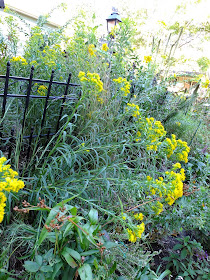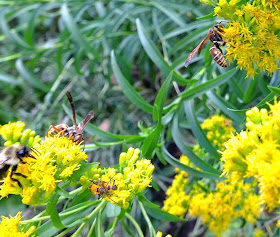There are several kinds of goldenrod growing in our yard. I don't remember what kind this first one is, but I've had this kind for quite a few years, and it has seeded itself around the yard. It looks the closest to the native goldenrod most people are familiar with, which some blame for hay fever, but the true culprits are wind pollinated plants, such as ragweed.
Stiff goldenrod, Oligoneuron rigidum, native to our area, is also seeding some in the yard, but is not stiff. I tie it up, but it still flops, especially this year, I think, because of all the rain we've had maybe. Next year, I plan to cut it back in the spring to see if it will bush out more and not flop.
Still, there have been pollinators and other critters making use of them.
The day after these were taken, I noticed a whole lot of activity on the Stiff goldenrod, so took more photos.
There are several clumps of Riddell's goldenrod, Oligoneuron riddelli, native to the states north, south and east of us, and only this one is sprawling. I'll try to get it tied up in the next few days.
This is also Riddell's goldenrod, directly behind the sprawling clump.
These plants had the most activity today. I wish I could remember the names of the wasps and bees that visit the plants.
There were three wasps on the blooms. The one on the left was smaller than the one on the right, which is also in the previous photo. There was a third one that I'm thinking was the size of the smaller one.
This is one of the smaller ones. After looking at the photos, I'm thinking the smaller ones were the same kind of wasp as the larger one, so maybe it's because one is male or female, and the other two are the other.
This is another photo of the larger one.
This clump may be a self sown one from across the yard. It is smaller than the others, and nice and upright. The bicycle also provides some support for it.
It also had some visitors. I'm not sure what kind of bee this is, but it is smaller than a honey bee.
There were different kinds of wasps as well. My hand got very close to most of the bees and wasps, like it usually does. With this one, I got within a couple inches, and it did not seem phased.
I am not sure what the three small insects are, but they were very tiny. The one on the right may be a sweat bee.
This wasp was smaller than the others, maybe 3/4 to an inch.
Zigzag goldenrod, Solidago flexicaulis, is difficult for me to photograph. This is one that can take some shade and likes moisture.
Here is a closer view of the blooms. This does get visited by insects, but not as many as some of the other goldenrods.
Fireworks goldenrod, Solidago rugosa, 'Fireworks' is a fun cultivar I bought several of from the Nebraska Statewide Arboretum plant sales.
It has just started to bloom. I only saw one insect on it this day.
In the back yard, the 'Wichita mountains' goldenrod, Solidao, 'Wichita Mountains' blooms are not quite open, but should be soon. This is one that gets lots of insect activity.
What kinds of goldenrod do you grow? Do you see lots of activity on them? I am not ready for fall, but we sure are having cooler temperatures. I think this week is expected to have highs in the 70s. I guess that does sound good.
Stiff goldenrod, Oligoneuron rigidum, native to our area, is also seeding some in the yard, but is not stiff. I tie it up, but it still flops, especially this year, I think, because of all the rain we've had maybe. Next year, I plan to cut it back in the spring to see if it will bush out more and not flop.
Still, there have been pollinators and other critters making use of them.
The day after these were taken, I noticed a whole lot of activity on the Stiff goldenrod, so took more photos.
There are several clumps of Riddell's goldenrod, Oligoneuron riddelli, native to the states north, south and east of us, and only this one is sprawling. I'll try to get it tied up in the next few days.
This is also Riddell's goldenrod, directly behind the sprawling clump.
These plants had the most activity today. I wish I could remember the names of the wasps and bees that visit the plants.
There were three wasps on the blooms. The one on the left was smaller than the one on the right, which is also in the previous photo. There was a third one that I'm thinking was the size of the smaller one.
This is one of the smaller ones. After looking at the photos, I'm thinking the smaller ones were the same kind of wasp as the larger one, so maybe it's because one is male or female, and the other two are the other.
This is another photo of the larger one.
This clump may be a self sown one from across the yard. It is smaller than the others, and nice and upright. The bicycle also provides some support for it.
It also had some visitors. I'm not sure what kind of bee this is, but it is smaller than a honey bee.
There were different kinds of wasps as well. My hand got very close to most of the bees and wasps, like it usually does. With this one, I got within a couple inches, and it did not seem phased.
I am not sure what the three small insects are, but they were very tiny. The one on the right may be a sweat bee.
This wasp was smaller than the others, maybe 3/4 to an inch.
Zigzag goldenrod, Solidago flexicaulis, is difficult for me to photograph. This is one that can take some shade and likes moisture.
Here is a closer view of the blooms. This does get visited by insects, but not as many as some of the other goldenrods.
Fireworks goldenrod, Solidago rugosa, 'Fireworks' is a fun cultivar I bought several of from the Nebraska Statewide Arboretum plant sales.
It has just started to bloom. I only saw one insect on it this day.
In the back yard, the 'Wichita mountains' goldenrod, Solidao, 'Wichita Mountains' blooms are not quite open, but should be soon. This is one that gets lots of insect activity.
What kinds of goldenrod do you grow? Do you see lots of activity on them? I am not ready for fall, but we sure are having cooler temperatures. I think this week is expected to have highs in the 70s. I guess that does sound good.























Great as meal for the wasps as well! Wonderful plant but I don't think we have this in my place. Happy gardening!
ReplyDeleteYour garden is a pollinator heaven in all seasons, Sue! I've always loved Goldenrod plants, so I'm glad that people are realizing their allergies are caused by other plants. Most of the Goldenrods are not only beautiful but also great cut flowers and butterfly and pollinator magnets. Beautiful photos!
ReplyDeleteI gave up growing Solidago because it tended to just flop everywhere, but it looks pretty spectacular in your garden! I love the 'Fireworks' variety, that is so pretty. Seems like the insects are being kept busy with it all :-) .
ReplyDeleteSo many goldenrod grow along the roads here....it never occurred to me to include them in my flower beds.....but I think I will next year. They ARE beautiful and should look lovely interspersed with my black-eyed Susans and Russian sage, etc.
ReplyDeleteSue, fall is definitely upon us. I'm starting garden cleanup already. Well, that is if the rain ever quits. Goldenrod, after all, is our state flower and grows wild every where. It has gotten a bad rap for being the reason for allergies but as you mentioned it's almost always the rag weed that matures the same time as Goldenrod. Since I come from a row crop farming back ground I never got passed the weed mentality and saw the beauty in Goldenrod. Reading your blog over the last couple years has opened up my mind to see that all the plants I chalked up as weeds are native plants that attract pollinators to the garden. A few years ago, I would have looked at your corner garden and thought it to be an unattended weed mess. Thank you for enlightening me to a whole new look at plants and their beauty.
ReplyDeleteHave a great day with Goldenrod in the garden.
Great post on goldenrods! They are one of my favorite plant groups, along with asters, because of the wonderful smears of color and pollinator activity they create in the fall.
ReplyDeleteOne species of goldenrod that I have and love, which you didn't mention, is elm-leafed goldenrod, Solidago ulmifolia. Elm-leafed goldenrod likes dry shade, where it really lights up dark corners. I've had it for about 6 years; last year was the first year that it reseeded for me. We had an unusually wet August last year, so presumably that was a positive for this species' reproduction. Otherwise it has been very "well behaved" - the clumps haven't even really increased much in size over the years - and the stems have generally stayed upright with no need to stake them at all. I highly recommend it!
I recently discovered UNL's extension site, THE BUZZ AT CHERRY CREEK , and we are planning to include some mason bee habitats in our back yard. I bet they'd love to hear about your garden and perhaps survey your insect population.
ReplyDeleteHi etienetteblue, I just read a couple of your journal entries, and was going to leave a comment about your curb finds, but I was not able to leave one because of the way you have it set up. I love the baby gate idea for peas to grow on. I am friends with some of the people who work at the arboretum, and they know about the bees and such, but I don't think I've met anyone who does the mason bee habitats. It would be cool to have someone survey the insects. There sure are a lot of them!
DeleteI grow many different ones and many have seeded themselves from surrounding areas. I adore any and all goldenrod and my meadow is ablaze with all the goldenrod right now. Makes the pollinators so happy.
ReplyDeleteThis is my first visit to your blog, so thanks very much for the post! Lovely photos of the varied insect life which visits your Goldenrod
ReplyDeleteHi Sue, You certainly have your share of pollinators......your gardens are beautiful and an inspiration to me. I have several Golden Rod in my garden but don't know what they are. No surprise there! The pollinators do love them and the Joe Pye Weed as well.....
ReplyDeleteHi Sue. Your goldenrod plants look so happy and the critters must really love it. Some of the bees are kind of creepy. :)
ReplyDeleteHaving seen some tiny sprigs of golden rod in a flower display I am thinking of planting one, When I was a child I remember large clumps growing wild, I'll either need a smallish restrained variety for the garden or will need to grow it on the allotment, Any advice would be welcome.
ReplyDelete